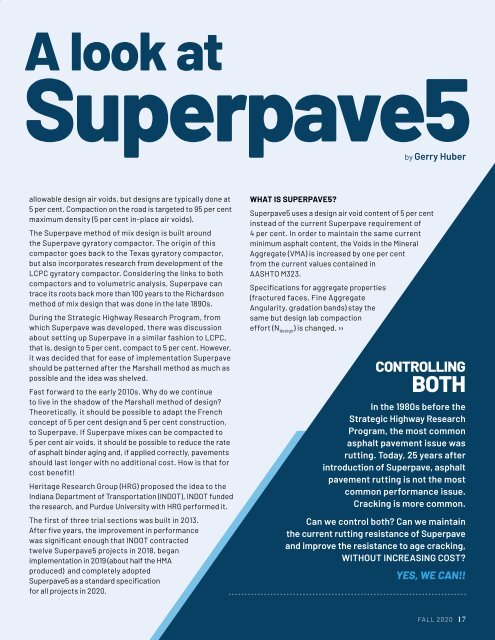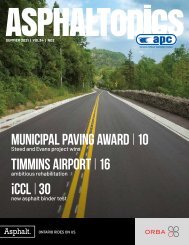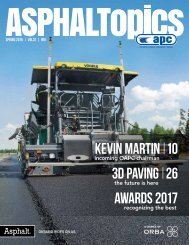ASPHALTopics | Fall 2020 | VOL 33 | NO 3
You also want an ePaper? Increase the reach of your titles
YUMPU automatically turns print PDFs into web optimized ePapers that Google loves.
A look at<br />
Superpave5<br />
by Gerry Huber<br />
allowable design air voids, but designs are typically done at<br />
5 per cent. Compaction on the road is targeted to 95 per cent<br />
maximum density (5 per cent in-place air voids).<br />
The Superpave method of mix design is built around<br />
the Superpave gyratory compactor. The origin of this<br />
compactor goes back to the Texas gyratory compactor,<br />
but also incorporates research from development of the<br />
LCPC gyratory compactor. Considering the links to both<br />
compactors and to volumetric analysis, Superpave can<br />
trace its roots back more than 100 years to the Richardson<br />
method of mix design that was done in the late 1890s.<br />
During the Strategic Highway Research Program, from<br />
which Superpave was developed, there was discussion<br />
about setting up Superpave in a similar fashion to LCPC,<br />
that is, design to 5 per cent, compact to 5 per cent. However,<br />
it was decided that for ease of implementation Superpave<br />
should be patterned after the Marshall method as much as<br />
possible and the idea was shelved.<br />
Fast forward to the early 2010s. Why do we continue<br />
to live in the shadow of the Marshall method of design?<br />
Theoretically, it should be possible to adapt the French<br />
concept of 5 per cent design and 5 per cent construction,<br />
to Superpave. If Superpave mixes can be compacted to<br />
5 per cent air voids, it should be possible to reduce the rate<br />
of asphalt binder aging and, if applied correctly, pavements<br />
should last longer with no additional cost. How is that for<br />
cost benefit!<br />
Heritage Research Group (HRG) proposed the idea to the<br />
Indiana Department of Transportation (INDOT), INDOT funded<br />
the research, and Purdue University with HRG performed it.<br />
The first of three trial sections was built in 2013.<br />
After five years, the improvement in performance<br />
was significant enough that INDOT contracted<br />
twelve Superpave5 projects in 2018, began<br />
implementation in 2019 (about half the HMA<br />
produced) and completely adopted<br />
Superpave5 as a standard specification<br />
for all projects in <strong>2020</strong>.<br />
WHAT IS SUPERPAVE5?<br />
Superpave5 uses a design air void content of 5 per cent<br />
instead of the current Superpave requirement of<br />
4 per cent. In order to maintain the same current<br />
minimum asphalt content, the Voids in the Mineral<br />
Aggregate (VMA) is increased by one per cent<br />
from the current values contained in<br />
AASHTO M323.<br />
Specifications for aggregate properties<br />
(fractured faces, Fine Aggregate<br />
Angularity, gradation bands) stay the<br />
same but design lab compaction<br />
effort (N design ) is changed. ››<br />
CONTROLLING<br />
BOTH<br />
In the 1980s before the<br />
Strategic Highway Research<br />
Program, the most common<br />
asphalt pavement issue was<br />
rutting. Today, 25 years after<br />
introduction of Superpave, asphalt<br />
pavement rutting is not the most<br />
common performance issue.<br />
Cracking is more common.<br />
Can we control both? Can we maintain<br />
the current rutting resistance of Superpave<br />
and improve the resistance to age cracking,<br />
WITHOUT INCREASING COST?<br />
YES, WE CAN!!<br />
FALL <strong>2020</strong> 17

















